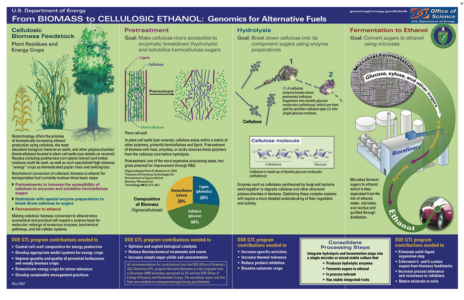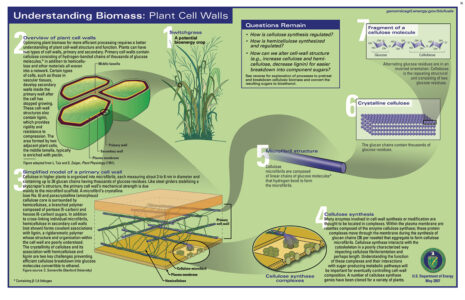Biofuels Primer Placemat
The Biofuels Primer is a two-page, 11″ x 17″ color document with the following contents
Summary
Understanding Biomass: Plant Cell Walls — A first step to optimizing feedstocks for fuel production
Optimizing plant biomass for more efficient processing requires a better understanding of plant cell-wall structure and function. Plant cell walls contain long chains of sugars (polysaccharides) that can be converted to transportation fuels such as ethanol. The saccharification process involves using enzymes to break down (hydrolyze) the polysaccharides into their component sugars for fermentation by microbes to ethanol. Significant challenges for efficient conversion are presented by both the large number of enzymes required to hydrolyze diverse sugar linkages and the physical inaccessibility of these compounds to enzymes because other cell-wall components are present.
Plant cell walls contain four different polymer types—cellulose microfibrils, hemicelluloses, pectins, and lignins. Microfibrils perform an important role in strengthening cell walls, thus providing support to the overall plant body. Some properties of lignin, however, interfere with enzymatic conversion of polysaccharide components. Additionally, since lignin is not readily converted to ethanol, we must find other ways it can be used if we are to maximize the yield of energy from biomass.
Several thousand genes are estimated to participate in cell-wall synthesis, deposition, and function, but very few genes have been identified and very little is known about their corresponding enzymes. Many questions remain, for example, regarding how polysaccharides and lignin are synthesized, how wall composition is regulated, and how composition relates to the biological functions of cell walls. To answer these questions, we need to discover the functions of many hundreds of enzymes, where proteins are located within cells, whether or not they are in complexes, where and when the corresponding genes are expressed, and which genes control the expression and activities of proteins involved. Application of new or improved biological, physical, analytical, and mathematical tools will facilitate a detailed mechanistic understanding of cell walls. That knowledge will permit optimization of various processes involved in producing biomass and converting it to fuels.
Major opportunities exist to increase productivity and conversion-process efficiencies by altering fundamental aspects of plant growth, development, and response to biotic and abiotic stress. Altering cell-wall composition to increase the relative amount of cellulose and to decrease lignin, for example, could have significant effects. Eventual development of a comprehensive physi- ological cell-wall model incorporating biophysical aspects with structural properties and knowledge of proteins involved will aid in rational development of highly productive feedstock species whose cell walls are optimized for conversion.


